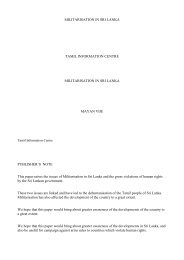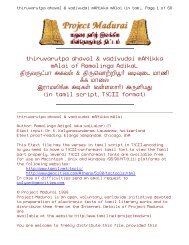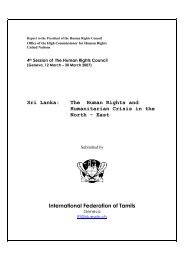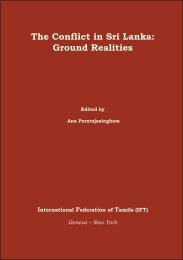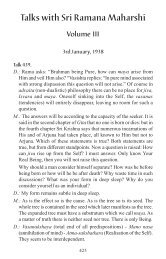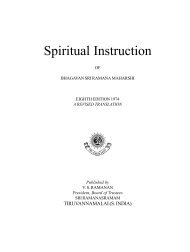Clyde Winters - Tamil Nation & Beyond
Clyde Winters - Tamil Nation & Beyond
Clyde Winters - Tamil Nation & Beyond
You also want an ePaper? Increase the reach of your titles
YUMPU automatically turns print PDFs into web optimized ePapers that Google loves.
ByDr. <strong>Clyde</strong> A. <strong>Winters</strong>The Indus Valley seals provide its bearers with a code for living. Each sealcontains messages to the bearer of the seal that provides seal bearer a guide forright conduct for themselves, throughout their life so they could obtain goodnessand while they merge with God—the Absolute Reality.The Harappan seals carry messages addressed to their Gods requestingsupport and assistance in obtaining aram ‘benevolence’.As a result the Harappan seals are amulets or talismans requesting someform of blessing for its bearer, from his personal god. These request sentenceswere formed in simple phrases like those found in Tiru Kural/ Holy Kural writtenby the weaver Saint Tiruvalluvar. The Harappan request sentences were formedby a simple verb, and additional introductory elements.Harappan seals were found in almost every room excavated . This indicatesthat writing was well known among the Harappans. This view is further supportedby the appearance of Harappan signs on many different types of artifacts,including pottery, axes and copper plates.Harappan texts are very short. They usually number three to four signs perseal. In this way the Harappan seals are similar to the later Indian seals and their
inscriptions studied by K.K. Thapliiyal, in Studies in ancient Indian seals .Theseals have only a few signs because each Harappan symbol represented one ormore words.Harappan texts are found on over 400 inscribed seals. The seals wereamulets, tied with string and carried/worn by the Harappan people. TheHarappan writing is read from right to left.Each Harappan sign has a syllabic value. Due to the monosyllabic natureof the Dravidian language spoken among the Harappans, each sign representeda word.Researchers have determined that the Harappan or Indus Valley script hasaround 419 signs. Of these 419 signs 113 occur only once, 47 occur twice and59 occur les than 5 times. This means that around 200 Harappan signs, most ofthem ligatures, were in general use.The Harappan seals have been found at over 60 different sites. The copperplates of the Harappans have only been found at Mohenjo-Daro.There are two major types of Harappan seals, one type square with shortinscription above a carved animal motif. The second type of seal is rectangularand contains only an inscription.
The seals range in size from a half-inch to around two-and-half inches. Ninetypercent of the seals are square, and 10 percent are rectangular.The seals are carved from steatite. Each seal had a raised boss on the backpierced with a hole for carrying or being placed on parcels.Figure 1: The Basic Harappan SignsThe Harappan writing system is a logo-syllabic system. The Harappan signsrecord messages to the seal bearer on right living and goodness. The animalmotifs were used to express the Dravidian deities of the Harappans. My researchindicates that the Harappan script consist of 60-70 basic syllabic signs and 10
idiographic signs(see Figure 1). These signs are joined together to form themajority of the 419 signs associated with Harappan writing. Study and learning ofthese 62 basic signs will allow one to read practically all of the Indus Valleyseals.The Indus Valley writing because it is logo-syllabic contains signs that are CV(consonant-vowel) and CVC type morphemes. The Harappan words weremonosyllabic.In the Harappan writing there are only a few ideographic signs. The mostcommon ideographic signs are min ‘illumination’ and āl‘maintain, keep; laborer; cherish; servant; to rule’.The Harappan signs are clear and straight rectilinear signs. The script showslittle evolution in shape and size from the writing used by other Proto-Saharanpeople in Sumer, Elam, the Fezzan in Africa and Minoan Crete. The averagelength of the seal text is half a dozen signs, the longest seal text is of 26 signs.In the Harappan seals the talismanic formula was : Depiction of Deity X as ananimal, and then a votive inscription was written above the Deity.
In the seal above we see a depiction of the Harappan God Mal (Vishnu orKatavu. Under the head of the God Mal we see a symbol many researchers calla Manger. The manger is composed of three signs pū i pā , thewords pū i pā mean “A flourishing condition thou distribute (it)” or “Thoudistribute a flourishing condition”.Many Harappan signs are homophones. As a result of homophony inHarappan writing the person attempting to decipher, or read a particularHarappan sign must carefully observe the general semantics of each inscription.The order of the Harappan sentence is verb object subject (VOS). EachHarappan sentence has a noun phrase (NP) , verb phrase (VP) and an article(art.). For example:Reading the signs from left to right beginning with the circle sign we read:Ta vey e ta ippo Uss pā ta ‘ Give (me) awareness, give (it) now. Fate give (its)distribution’.Reading from right to left we have Ta(r) ya i tū ta ‘ Ye who binds, thou bringvirtue here’.Below we list the basic Harappan signs and their meanings. The meaningsof these signs come from T. Burrow and M.B. Emeneau’s A Dravidian
Etymological Dictionary 1 and K. Appadurai’s The Mind and Thought ofTiruvalluvar . The Harappan signs are given the phonetic value of the signsrecorded in the Vai script, a writing system used by the Mande speaking peopleof West Africa. Although the Harappan signs are given the phonetic values of theVai characters, the phonetic values are read using Dravidian (<strong>Tamil</strong>) morphemes.For example, Appadurai said that in the Tiru Kural, the term Uzh > Usscorresponds to the ‘Life Power aspect of Fate’, while word pā during the writingof the Tolkappiyam denoted Karma. In Sangam times pāl was considered thesum and the consequences of a person’s action, i.e., his fate, destiny’. The termpāl was also used by Tiruvalluvar to denote ‘fate or the law of nature’.List of Basic Harappan Signsuy, ‘soul, to live, to subsist, have being, salvation, to ensure, to be relieved(from trouble), escape from dangera,aga vey, ‘equality in bloom’; ‘mayest thou blossom (on me)’1A digital version of T. Burrow and M.B. Emeneau’s A DravidianEtymological Dictionary can be found on the web at:http://dsal.uchicago.edu/dictionaries/burrow/. This digital version does notcontain all the definitions of Dravidian words found in the hard copy.
agappal, ‘Inner Path’tu ga vey, ‘make virtue bloom’al, ‘maintain, keep, maintain in use; laborer, servant; manage, to rule, reignover ; man’a minandannal , ‘superiority, righteousness, greatman; greatness, king,god’ga or luI, -I, this particle has many usese in Harappan, it means ‘to give’, it canalso be used to as the past tense formative, e.g.,pā-I ‘do not divide’; thou,you; the demonstrative ‘this’, the inflexion of neuter nouns; and ‘give it, permit, tolet’.i-ka, ‘thou to preserve’
i-po, ‘give richness; give (its) birth; give a flourishing condition’ippo, ‘Now’ka , ‘balance, equality; to preserve, shelter, watch, guard, ward off, rescue,protect; forest; protection, protector, guardian’ka annal, ‘preserve righteousness’Kaka, ‘deliverance , protection; safe keeping’ka vey, ‘equality in bloom; pleasure grove blossom; paradise bloom’terul, ‘ to know, gain true knowledge, perceive, ascertain, understandclearly; be clean, lucid, intelligence, wisdom, comprehension’kumari, ‘paradise’ta, ‘to give, to bring’ga, ‘mayest’me , ‘truth, reality, soul consciousness, excellence; to excel, surpass’
min , ‘illumination, to shine, glitter; phosphorescent, glow’min-i, ‘thou illumination’ or ‘illumination give it’nil, ‘steadfast; to stand, to be long, to be great; loftiness’andpa, ‘Karma, destiny; to divide, to distribute; -pa pluraltermination; a term that corresponds to the personalimpersonal aspects of God, God as a Friend and Guide, andGod as Compassion and as Dispenser of Mercy’pa-I , ‘give distribution of God’s Mercy’; give the distribution; thou distributepāpā, true it is, indeed; distribute God’s Mercy’papapa, ‘Indeed distribute much of God’s Mercy’po, ‘to go, proceed, go away; reach a distination; richness, flourishingcondition, flower bloom; to create, give birth; -i the formative particlepopo / pupu, ‘create/ give birth to a flourishing condition’andpuka, ‘glory, fame, equality, equality of division
say or sey, ‘straightness, righteousness, merit, rectitude; v. to do, make,create, cause; deed, act, action; uprightness, incororruptibility,honorableness, high character’, and tā, ‘to give, to bring; here, place; blemish, defect; -ta theimperative suffix.tā pāpā,tar ya, ‘Ye who binds’tātā, ‘large, broad, full; greatness, glory; bestow on me greatness’tar pasu, ‘ye distribute’tā tā, large, broad, full; greatness, glory; bestow on (me) greatness,tū tū, ‘abundant virtue, abundant purity’tū Uss, ‘Virtuous Fate’tū ga vey, ‘make virtue bloom’
tuppu, cleanliness, purificationu , demonstrative ‘this’, verb: ‘to bring’, it can also represent the singularending particle -u.(uzh) uss, Fate, Power of God, Law of Nature (This was a generic termused to denote the power of God, expressed in terms of justice).u- tūtū, ‘to put (on), surround, encircle; utātā ‘to bring greatness, to bringglory’uy ta, ‘Salvation’vēy, to come, put on, roof; blossom, open; Florence, growth, development’terul, ‘knowledge’; i pa ‘give perfection’,(y)eLearn these Harappan terms and you will be able to read most Harappan theHarappan seals.



